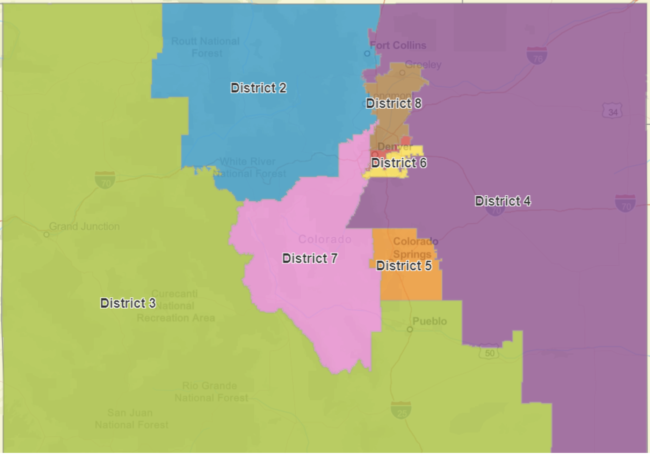
CO-04 (Special Election)
See Full Big Line
(R) Greg Lopez
(R) Trisha Calvarese
90%
10%

President (To Win Colorado)
See Full Big Line
(D) Joe Biden*
(R) Donald Trump
80%
20%↓

CO-01 (Denver)
See Full Big Line
(D) Diana DeGette*
90%

CO-02 (Boulder-ish)
See Full Big Line
(D) Joe Neguse*
90%

CO-03 (West & Southern CO)
See Full Big Line
(D) Adam Frisch
(R) Jeff Hurd
(R) Ron Hanks
40%
30%
20%

CO-04 (Northeast-ish Colorado)
See Full Big Line
(R) Lauren Boebert
(R) Deborah Flora
(R) J. Sonnenberg
30%↑
15%↑
10%↓

CO-05 (Colorado Springs)
See Full Big Line
(R) Dave Williams
(R) Jeff Crank
50%↓
50%↑

CO-06 (Aurora)
See Full Big Line
(D) Jason Crow*
90%

CO-07 (Jefferson County)
See Full Big Line
(D) Brittany Pettersen
85%↑

CO-08 (Northern Colo.)
See Full Big Line
(D) Yadira Caraveo
(R) Gabe Evans
(R) Janak Joshi
60%↑
35%↓
30%↑

State Senate Majority
See Full Big Line
DEMOCRATS
REPUBLICANS
80%
20%

State House Majority
See Full Big Line
DEMOCRATS
REPUBLICANS
95%
5%
 October 28, 2021 10:29 AM UTC
October 28, 2021 10:29 AM UTC 5 Comments
5 Comments As Colorado’s newly-created independent redistricting commissions charged with drawing new maps for the state’s congressional and legislative districts churned through its meticulously-defined process this year, a process designed to install partisan “balance” to a process crucial to both sides’ partisan aspirations for the coming decade, many Colorado Democrats who won a huge majority in Colorado the same year Amendments Y&Z passed in 2018 and retained it easily in 2020 openly lamented having ceded undue power over the redistricting process to a shrinking Republican minority.
As Colorado’s newly-created independent redistricting commissions charged with drawing new maps for the state’s congressional and legislative districts churned through its meticulously-defined process this year, a process designed to install partisan “balance” to a process crucial to both sides’ partisan aspirations for the coming decade, many Colorado Democrats who won a huge majority in Colorado the same year Amendments Y&Z passed in 2018 and retained it easily in 2020 openly lamented having ceded undue power over the redistricting process to a shrinking Republican minority.
Yup. Here in Colorado the Democrats are using their majority to bend over backwards to be fair to the minority; while everywhere else, the GOP is trying to decide if it's more fun for the concentration camps to have electric fences or attack dogs.
Since the commissions were charged with, among other things, drawing competitive districts, I would have preferred to see CD 3 made to look like CD 8 in exchange for making the General Assembly districts not quite as D-slanted as they are under the new maps.
With CD 3 and 8 as toss ups, best case scenario for the Dems would be 6 to 2, worst case would be 4 to 4.
Would CD 3 truly be a tossup, though?
Though, picking that up might mess up our favorite troll's income.
Point well taken. Given the fact that the only types of Dems who could get elected in that district over the past 40 years have been Ben Nighthorse Campbell and John Salazar, even those registered as Dems in CD 3 are actually what used to be moderate Republicans.
Trying to guess "partisan lean" and "competitiveness" by examining 8 state-wide races from 2016, 2018, and 2020 seemed an odd choice to me. State House and Senate races do not neatly "match" statewide campaigns, and certainly do not match the US Senate contests. Yet as best I can tell, there was no consideration of the actual history of voting for the state legislature.
Wherever the lines are set, candidates are going to need to adjust not only to the broad partisan themes, but to local priorities and issues.